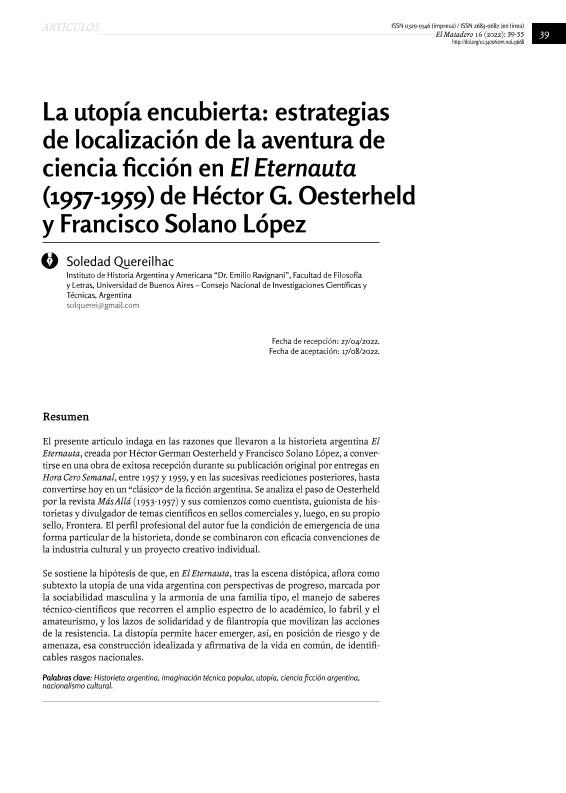Artículo
El presente artículo indaga en las razones que llevaron a la historieta argentina ElEternauta, creada por Héctor German Oesterheld y Francisco Solano López, a convertirse enuna obra de exitosa recepción durante su publicación original por entregas en Hora CeroSemanal, entre 1957 y 1959, y en las sucesivas reediciones posteriores, hasta convertirse hoyen un ´clásico´ de la ficción argentina. Se analiza el paso de Oesterheld por la revista MásAllá (1953-1957) y sus comienzos como cuentista, guionista de historietas y divulgador detemas científicos en sellos comerciales y, luego, en su propio sello, Frontera. El perfilprofesional del autor fue la condición de emergencia de una forma particular de la historieta,donde se combinaron con eficacia convenciones de la industria cultural y un proyectocreativo individual.Se sostiene la hipótesis de que, en El Eternauta, tras la escena distópica, aflora comosubtexto la utopía de una vida argentina con perspectivas de progreso, marcada por lasociabilidad masculina y la armonía de una familia tipo, el manejo de saberes técnicocientíficosque recorren el amplio espectro de lo académico, lo fabril y el amateurismo, y loslazos de solidaridad y de filantropía que movilizan las acciones de la resistencia. La distopíapermite hacer emerger, así, en posición de riesgo y de amenaza, esa construcción idealizaday afirmativa de la vida en común, de identificables rasgos nacionales. This article explores the reasons that led the Argentine comic book El Eternauta, created by Héctor German Oesterheld and Francisco Solano López, to become a success during its original publication in Hora Cero Semanal (1957-1959), as well as in subsequent reprints, until becoming into a “classic” of Argentine fiction. The article analyzes Oesterheld’s work at the magazine Más Allá (1953-1957) and his beginnings as a short story writer, comic book scriptwriter, and disseminator of scientific knowledge in commercial publishing houses and, later, in his own company, Frontera. The author’s professional profile was the emergence condition of a particular form of Argentine comics, where cultural industry conventions and an individual creative project were effectively combined. This article sustains the hypothesis that, in El Eternauta, behind the dystopian scene, the utopia of an Argentinean life with prospects of progress emerges as subtext, defined by male sociability and the harmony of a nuclear family, the handling of technical-scientific knowledge that covers the broad spectrum of academia, industry, and amateurism, and the bonds of solidarity and philanthropy that mobilize the actions of the resistance. Thus, the dystopia allows that idealized and positive representation of the life in common to emerge in a position of risk and threat.
La utopía encubierta: estrategias de localización de la aventura de ciencia ficción en El Eternauta (1957-1959) de Héctor G. Oesterheld y Francisco Solano López
Título:
The Hidden Utopia: Strategies for Nationalizing the Science Fiction Adventure in El Eternauta (1957-1959) by Héctor G. Oesterheld and Francisco Solano López
Fecha de publicación:
03/2023
Editorial:
Universidad de Buenos Aires. Facultad de Filosofía y Letras. Instituto de Literatura Argentina Ricardo Rojas
Revista:
El Matadero. Revista crítica de literatura argentina
ISSN:
0329-9546
Idioma:
Español
Tipo de recurso:
Artículo publicado
Clasificación temática:
Resumen
Archivos asociados
Licencia
Identificadores
Colecciones
Articulos(INSTITUTO "DR. E.RAVIGNANI")
Articulos de INST. DE HISTORIA ARGENTINA Y AMERICANA "DR. EMILIO RAVIGNANI"
Articulos de INST. DE HISTORIA ARGENTINA Y AMERICANA "DR. EMILIO RAVIGNANI"
Citación
Quereilhac, Soledad; La utopía encubierta: estrategias de localización de la aventura de ciencia ficción en El Eternauta (1957-1959) de Héctor G. Oesterheld y Francisco Solano López; Universidad de Buenos Aires. Facultad de Filosofía y Letras. Instituto de Literatura Argentina Ricardo Rojas; El Matadero. Revista crítica de literatura argentina; 3-2023; 1-17
Compartir
Altmétricas




